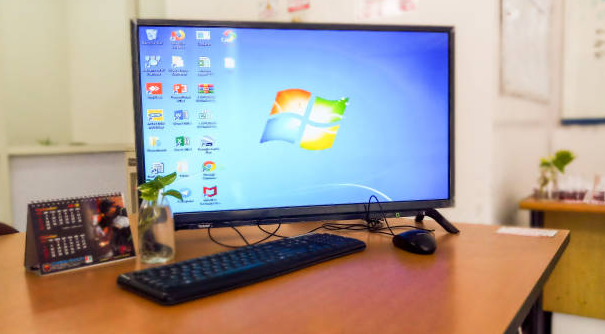
Remote desktop functionality has become increasingly popular in today’s digital landscape. Whether you work from home, need to access your office computer while traveling, or simply want the convenience of remotely controlling another device, setting up remote desktop on your Windows 10 computer can be a game-changer. In this article, we’ll guide you through the process of setting up remote desktop on Windows 10 and provide best practices to ensure a secure and smooth remote desktop experience.
I. Introduction
Remote desktop refers to the ability to access and control a computer or device from a remote location, using a network connection. It allows users to interact with their computer as if they were physically present at the device. This technology has revolutionized the way people work and has become an essential tool in various industries.
II. Understanding Remote Desktop
Remote desktop works by utilizing remote desktop software or built-in features in operating systems like Windows 10. When enabled, it allows a user to connect to another computer over a network connection, granting full access and control over the remote system. This technology is particularly useful for troubleshooting purposes, accessing files and applications remotely, or collaborating with colleagues in different locations.
The benefits of using remote desktop are numerous. It enables flexibility by allowing users to work from anywhere, enhances productivity by providing seamless access to important files and applications, and simplifies IT support by enabling remote troubleshooting and maintenance.
III. Setting Up Remote Desktop on Windows 10
Before setting up remote desktop on Windows 10, it’s essential to ensure that your system meets the necessary requirements and have the required permissions. Follow the steps below to set up remote desktop on your Windows 10 computer:
A. Checking System Requirements
- Compatible Windows 10 version: Make sure you have a Windows 10 Pro, Enterprise, or Education edition, as the Home edition doesn’t support remote desktop functionality.
- Active internet connection: Ensure that your computer is connected to the internet, as remote desktop requires network connectivity.
- Administrator access: You’ll need administrator access to enable and configure remote desktop settings.
B. Enabling Remote Desktop
- Open System Properties: Right-click on the Start button, select “System,” and click on “Properties” to open the System Properties window.
- Configure Remote settings: In the System Properties window, navigate to the “Remote” tab.
- Enable Remote Desktop connections: Under the “Remote Desktop” section, select the option “Allow remote connections to this computer.”
C. Setting Up Remote Desktop Connection
- Identify the target computer’s IP address: Note down the IP address of the computer you want to access remotely. You can find the IP address by opening the Command Prompt and typing “ipconfig.”
- Open Remote Desktop Connection app: Press the Windows key + R to open the Run dialog box, type “mstsc,” and press Enter to launch the Remote Desktop Connection app.
- Enter the target computer’s IP address: In the Remote Desktop Connection app, enter the IP address of the target computer in the “Computer” field.
D. Configuring Remote Desktop Settings
- Customize display options: Click on the “Display” tab in the Remote Desktop Connection app to adjust display settings like screen resolution, colors, and size.
- Adjust remote audio settings: Navigate to the “Local Resources” tab to configure audio settings for the remote desktop session.
- Configure local resources: In the same “Local Resources” tab, you can choose to share local devices like printers or drives with the remote computer.
E. Establishing Remote Desktop Connection
- Enter login credentials: Once you’ve configured the necessary settings, click on the “Connect” button to initiate the remote desktop connection. Enter the login credentials of the target computer when prompted.
- Verify the connection: If the login credentials are correct and the connection is successfully established, you’ll be able to control the remote desktop as if you were physically present at the computer.
F. Troubleshooting Common Issues
Remote desktop connections may sometimes encounter issues due to firewall or network configurations, permission problems, or connection errors. If you face any difficulties while setting up or using remote desktop on Windows 10, consider the following troubleshooting steps:
- Check firewall and network configurations: Ensure that the necessary ports (e.g., port 3389 for Remote Desktop Protocol) are open in the firewall settings of both the local and remote computers.
- Resolve permission and access problems: Verify that you have the appropriate user permissions on the target computer and that the account you’re using to connect has remote access privileges.
- Troubleshoot Remote Desktop connection errors: If you encounter any connection errors or issues, consult Microsoft’s official documentation or online forums for specific troubleshooting steps.
IV. Best Practices for Remote Desktop Usage
While remote desktop offers convenience and flexibility, it’s crucial to implement best practices to ensure a secure and reliable remote desktop experience. Consider the following tips:
- Implement strong security measures: Use a virtual private network (VPN) for remote connections, enable Network Level Authentication (NLA), and regularly update your Windows 10 and remote desktop software to stay protected against security vulnerabilities.
- Regularly update Windows and Remote Desktop software: Keep your operating system and remote desktop software up to date to benefit from the latest security patches and performance improvements.
- Use strong passwords and two-factor authentication: Set strong, unique passwords for your user accounts and enable two-factor authentication whenever possible to add an extra layer of security to your remote desktop connections.
- Monitor remote connections: Keep an eye on the connected devices and active sessions on your remote desktop, ensuring that unauthorized access attempts are promptly detected and mitigated.
V. Conclusion
Setting up remote desktop on Windows 10 provides you with the flexibility to access and control your computer from anywhere, enhancing productivity and convenience. By following the outlined steps and implementing best practices for remote desktop usage, you can enjoy a secure and seamless remote desktop experience. Embrace the power of remote desktop and explore the endless possibilities it offers.
Frequently Asked Questions (FAQs)
1. Can I use remote desktop on Windows 10 Home edition?
- No, remote desktop functionality is not available in Windows 10 Home edition. You need Windows 10 Pro, Enterprise, or Education edition to enable and use remote desktop.
2. Can I access my Windows 10 computer from a Mac using remote desktop?
- Yes, you can use remote desktop clients available for Mac, such as Microsoft Remote Desktop, to access your Windows 10 computer remotely.
3. Is remote desktop secure?
- Remote desktop can be secure if proper security measures are implemented. Using a VPN, enabling NLA, and following best practices like using strong passwords and two-factor authentication can help ensure the security of your remote desktop connections.
4. Can I transfer files between my local and remote computers using remote desktop?
- Yes, you can transfer files between your local and remote computers during a remote desktop session. The remote desktop software provides options to share files and folders between the connected devices.
5. Are there any alternatives to remote desktop on Windows 10?
- Yes, there are alternative remote desktop solutions available for Windows 10, such as TeamViewer, AnyDesk, and Chrome Remote Desktop. These tools offer similar functionality and can be used for remote access and control of computers.







